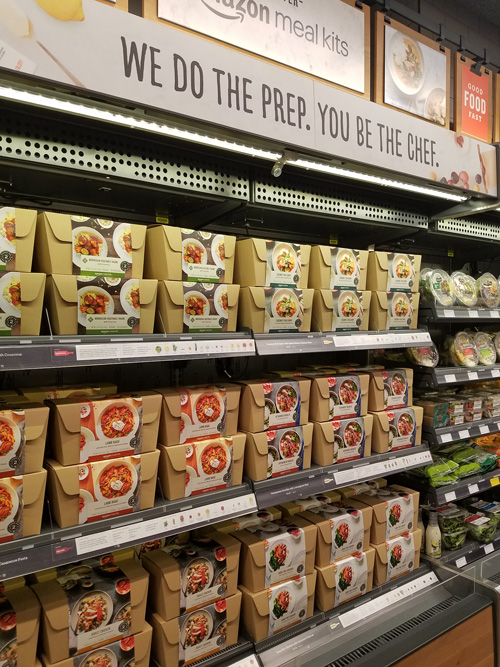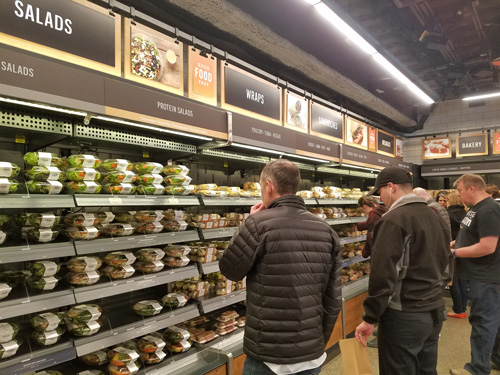By Frank Beard
SEATTLE – It seems that everyone wants to talk about Amazon Go—and for good reason. Not only has Amazon displayed a remarkable ability to disrupt multiple industries, but their convenience store brings innovation to a feature of the retail experience that has remained static for decades. When you’re finished shopping, you just walk out. That’s it. No checkouts, no lines, and no waiting for someone or something to process your payment.
Will Amazon Go disrupt the convenience retailing industry and its more than 154,000 stores across the United States? It’s doubtful—although speculation about what Amazon will or will not do is a bad business to be in.
But there is much to learn from Amazon Go thus far. Here are three takeaways from my recent visit.
1. Automation doesn’t have to be impersonal
Amazon Go has more employees than I suspected—and not just in their kitchens. Far from being the cold and impersonal environment that many speculated, the store is actually warm and welcoming. The staff steps back and enables a self-directed customer experience while remaining available to anyone who needs help or wonders, “do I really just walk out when I’m ready to go?”
This is interesting, because attempts to innovate payment and checkout processes are often discussed in the context of labor concerns. When quick-serve restaurants install touchscreen kiosks, speculation abounds regarding whether or not it’s a strategy to eliminate staff.
But Amazon Go appears to take a somewhat different approach. Without the need to scan items and take payments at a register, employees can focus their attention on other matters.
2. Know your customers
Amazon Go is located at the base of the company’s Day 1 office tower—a 521-foot-tall building belonging to a three-tower complex which forms Amazon’s headquarters. Directly next door are the new Amazon Spheres.
Spend a few minutes at the store, and it’s obvious that the core customers are downtown office professionals. Amazon itself is the largest private employer in Seattle with more than 40,000 on payroll. 15% live in the same zip code as their office, and about 20% walk to work. The product selection at the store is tailored to this type of mobile, localized customer. Freshly-prepared salads and sandwiches, ethnic flavors, high-quality beverages and snacks, and a wide range of small groceries that someone can take home after leaving work—including artisan cheeses, frozen meat, bottles of wine, and even Halo Top ice cream. The store also provides a range of creative meal kits that offer “dinner for 2 in about 30 minutes,” where “we do the prep” and “you be the chef.”
 Knowing the customer is essential for today’s convenience retailers, and Amazon gets it. But while convenience retailers are unlikely to beat Amazon at the data analytics game, location intelligence provides an opportunity for retailers to hone their competitive edge by gaining a complete understanding of consumers and their path to purchase.
Knowing the customer is essential for today’s convenience retailers, and Amazon gets it. But while convenience retailers are unlikely to beat Amazon at the data analytics game, location intelligence provides an opportunity for retailers to hone their competitive edge by gaining a complete understanding of consumers and their path to purchase.
Antonio Tomarchio, the CEO of Cuebiq, made this point in a recent article for AdWeek:
Embracing location intelligence also offers a benchmark that shows who is driving the customer’s journey. Combining marketing campaign and sales data with location intelligence can help retailers complete the picture and get a granular view of why a customer visited a store, how they engaged with the brand and what will bring them back.
3. Differentiate your product selection
What do you offer that nobody else does?
During my visit to Amazon Go, I enjoyed a fresh salad consisting of mixed greens, goat cheese, chopped dates, roasted pumpkin seeds, and a cider vinaigrette. This product alone would inspire repeat visits if I worked in downtown Seattle. But I also purchased baked tofu and enjoyed it with sriracha sauce, and I sampled yogurt with strawberry chia seed jam and fresh vanilla granola with almonds.
 Many of Amazon Go’s product offerings are unique, fresh, and prepared with quality ingredients. Their selection of CPGs and frozen goods is carefully-curated as well. As expected, Reuters recently reported that repeat business is common at the store.
Many of Amazon Go’s product offerings are unique, fresh, and prepared with quality ingredients. Their selection of CPGs and frozen goods is carefully-curated as well. As expected, Reuters recently reported that repeat business is common at the store.
This is a reminder for convenience retailers to pay careful attention to their own product offerings. Not just because Amazon Go has announced plans to build more stores, but because potentially-disruptive challenges are coming from multiple directions. Dollar General opened 1,315 stores last year, QSRs and fast-casuals are increasingly competitive, and delivery services continue to expand. GoPuff offers mobile ordering for thousands of SKUs with a promised delivery time of 30 minutes or less—and views itself as a replacement for convenience stores.
How does your brand differentiate itself? This is a question that increasingly demands an answer.
Frank Beard is a regular NACS Daily contributor who has traveled to more than 1,000 convenience stores in 24 states. He raised awareness of the industry's healthful food options with his “30 Days of Gas Station Food” experiment, and he's an analyst/evangelist for convenience store and retail trends at GasBuddy. Follow Frank on Twitter here.